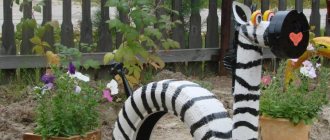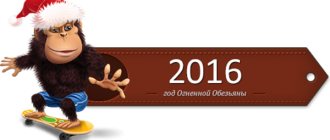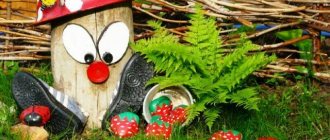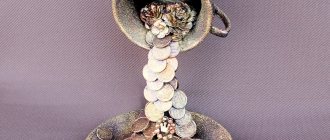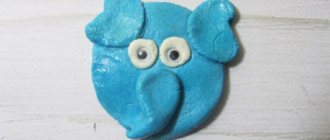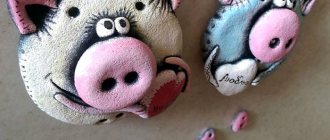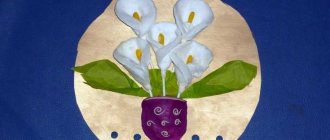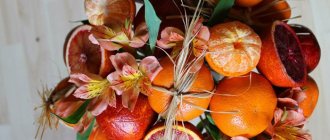Required materials and tools
Before starting work on creating soft toys, a novice craftsman needs to prepare all the necessary materials and tools for work. The sewing process and the final result depend on their correct selection.
Fabric selection
Fleece is the most common material used for sewing toys. This is due to the large number of positive qualities of this material:
- low price;
- brightness and variety of color palette;
- unpretentiousness at work;
- ease of fabric care.
It should be noted that for the manufacture of toys it is necessary to choose high-quality material with a density of at least 200 mg/m2. The downside of some fleece fabrics is their tendency to pill.
Most craftsmen recommend using pieces of fabric from old fleece items for the first trial work . This will allow you to gain experience in making soft toys without large financial costs.
Filler material
An important component of a handmade soft toy is its filling. The main criteria when choosing it are its safety and suitability for the baby’s age.
The most common types of filling for toys and crafts intended for children of all ages are padding polyester and holofiber . For beginning craftsmen and on a limited budget, it is acceptable to use cotton wool for stuffing small crafts. It should be taken into account that this type of filler can form into dense clumps during use and after washing.
In educational toys, calcined cereals are often used as a filler. They act as a weighting agent and help develop tactile sensations in babies. When playing with such crafts, it is important to strictly monitor the integrity of the toy and prevent small parts from accidentally getting into the respiratory tract of small children.
Decorative elements
Toys should be bright, interesting and attract the attention of children from the first minutes of playing with them. For this purpose, finished products are decorated with ribbons, lace, and appliqué. They dress them in clothes made from remnants of fabric used in other works. To give the craft a finished look, buttons, beads, and seed beads are often used.
If we sew toys from fleece with our own hands for personal use, then we can do without a sewing machine. You should consider purchasing it if you are making crafts for commercial purposes.
Before you start working on soft toys, you should prepare:
- needles;
- scissors (large and small);
- threads of various colors and shades;
- sewing pins;
- measuring tape;
- a piece of soap or marker.
Creating a pattern
Creating designer patterns is a rather complex and time-consuming process that is not always quickly mastered by novice craftsmen. When starting to create toys from fleece, you can look for patterns for them in several sources .
- The Internet, where you can find not only patterns, but also recommendations for choosing fabric, filling and decor.
- Specialized printed publications on needlework and sewing, which contain patterns and instructions for them.
- Kits for sewing soft toys, which are sold in art and craft stores.
- The source of the pattern can be an old toy. It can be ripped open and disassembled into parts, the silhouettes of which are transferred to new fabric.
How to make a bedspread with your own hands
Separately, it is worth paying attention to the material for making templates for patterns. The most suitable material for them is cardboard. The silhouette from such blanks is easy to transfer to fabric. They do not require additional fastening and are more durable compared to templates made from paper or tracing paper.
Fleece crafts for beginners
Having prepared all the necessary materials and tools, you can proceed to creating toys. What can a beginning craftsman sew from fleece? You should start getting acquainted with the world of fleece crafts with simple toys consisting of 1-2 parts.
Cat pillow
This toy consists of only 2 paired parts: a body and a tail. To sew it, you will need:
- a piece of bright fleece;
- a small piece of pink or red material;
- scissors;
- marker or piece of soap;
- blue and black threads;
- padding polyester
The pattern of this toy is quite simple, and you can draw it yourself on a sheet of paper of a suitable size.
The fabric must be folded in half with the right side facing inward. Place the pattern on it, which, if necessary, is secured to the fabric with pins. Outline the silhouette of the cat's body and its tail, leaving 5-7 mm for seams. Carefully cut out the details of the craft.
Place the paired pieces right sides facing each other and stitch. If we sew a fleece toy by hand, then the parts should be sewn together with a loop stitch, leaving a small area for stuffing the toy.
The sewn parts are turned right side out and filled with filler. The degree of stuffing should be adjusted based on your own preferences. The main thing is that the filler is evenly distributed throughout the product. To make it easier to fill the tail with padding polyester, it should be rolled up like a stocking and unfolded as it is filled.
Having filled the tail part, its end is stitched and sewn to the body with hidden stitches. To complete the pillow cat, cut out a nose from a piece of red fabric and sew it on with a blanket stitch. The arcs of closed eyes, muzzle and mustache are embroidered on the body with black threads, indicating the ears and tummy.
Teddy bear with a bow
Even with small children who can hold a pencil in their hands, you can make crafts from fleece with your own hands. Patterns for such crafts should be small and consist of one piece. Such a joint toy could be a small bear decorated with a bow. To complete it you will need:
- a piece of fleece measuring 30*30 cm in any color;
- a small piece of black fleece;
- two small black buttons;
- two - three colored buttons;
- scissors;
- needles;
- threads;
- satin ribbon;
- filler.
How to sew a rooster costume with your own hands using improvised materials
Work on a fleece bear begins by transferring the pattern onto the fabric. This work can be entrusted to a child. To work together with your child, it is necessary to initially set seam allowances to the size of the pattern, increasing them to 1 cm so that cutting inaccuracies can be hidden.
You can also entrust cutting out parts for a craft to a child who knows how to use scissors.
The next step in creating a soft toy is finishing with decorative details. A nose is cut out of a piece of black fleece and carefully sewn onto the front part of one of the parts.
Small black buttons are sewn just above the nose. These will be the bear's eyes. The mouth and cheeks are embroidered with black thread. Colored buttons are sewn vertically in the middle of the body.
Their color depends on the imagination of the authors.
After finishing the decoration, both parts are folded right sides inward and stitched, leaving a hole for stuffing. The toy can be stuffed by a child with the help of an adult, who regulates the degree of stuffing of the product and helps to evenly distribute the padding polyester inside the craft. The stuffing hole is sewn up with a hidden seam.
- The finished toy is decorated with a narrow satin ribbon tied in a bow.
-
Multi-piece fleece toys
Having mastered the technique of sewing simple fleece toys consisting of 1-2 parts, you can move on to the next level - sewing multi-part toys from fleece with your own hands. Master classes describe in detail the necessary materials, decorative elements and work progress.
Ladybug
All children like bright toys. And if your mother sews it with her own hands, then she will remain loved for many years. The soft ladybug is quite easy to sew. For it you will need:
- two large red circles;
- two large and several small black circles;
- strip of black fabric;
- black satin ribbon;
- black and red threads;
- needle;
- scissors;
- pins;
- small toy eyes;
- filler.
Work begins with decorating one of the red parts. A black stripe is pinned in the middle of the front side of the red circle. Small black circles are placed on both sides of it, fixing their location with pins. Then all the overlay parts are sewn to the base using an overlock stitch.
Large black circles are applied to both red parts. The parts must be folded with their front sides facing each other. The touching parts of the figures are sewn together with a loop stitch. The color of the threads at this stage of work does not matter, since they will be inside the craft.
Toy patterns
Creating an original pattern for a toy is not easy. This requires certain knowledge and experience.
Ready-made templates
Although fleece is a malleable material, and parts can literally be “fashioned” by correcting imperfections, it is still easier to use ready-made, precisely calculated templates. They are printed from the Internet, transferred onto cardboard using tracing paper from the pages of needlework magazines, or purchased in the form of ready-made sets. And detailed master classes will tell you how professionals make soft toys.
You might be interested in this: Making your own paper Christmas angels using templates
Rules for transferring patterns to fabric
Finding a good pattern is only half the battle. You need to correctly transfer it to fabric. Here you can’t do without knowing some of the nuances. Here is the basic procedure for transferring patterns to fabric:
- Lay the fleece face down on a smooth, flat surface.
Important! With fleece, especially if it is fleecy on both sides, it can be difficult to determine which is the face and which is the back. To do this, the fabric is carefully stretched across the grain thread (it is parallel to the factory edge) - the fleece is rolled up towards the wrong side.
The direction of the grain thread on fleece
- Place the templates compactly on the fleece. This can be done along or across the shared thread. This will result in two toys that are completely different in shape. For example, a bunny cut along the grain thread will be lower and thicker than one whose parts were cut across.
Pattern placement on fabric
Differences in finished products depending on the cutting direction
Additional information! Fleece is a voluminous and fluffy fabric. The appearance and shade of the fabric depend on the position of the pile. Therefore, the templates must be placed in one direction.
- Trace the templates with a sharp tailor's chalk or a contrasting pencil, avoiding significant creases in the pile.
- Carefully cut out the elements of the future toy with sharp scissors.
The edges of the cut parts do not require additional processing, since the fabric does not fray. For greater confidence, you can follow the contour with scissors with a raised edge.
DIY fleece toys: a simple material for creating unusual products
Fleece has been used for quite a long time and is often used to create toys in factories, but you can also make wonderful toys from this material yourself; moreover, this fabric is unpretentious and elastic, so flaws in stuffing and seams are invisible. Let's take a closer look at how you make your own fleece toys.
Wicker model
This material can be used to make not only children's toys, but also for your favorite pets, for example, dogs.
Required tools and materials:
- Three stripes of fleece in contrasting colors, about thirty centimeters long and seven centimeters wide;
- A thread;
- Weight for ease of weaving.
We take strips of fabric, apply them to each other, and then fix them in the center, wrapping them with thread.
We braid tight braids on both sides of the center with fabric braids, but not completely, to make this action comfortable, you can fix part of the braid with a heavy weight, as in the photo below.
We fold the resulting braid in half and fix the fold again. From the remaining strips we weave a spikelet or braid, braiding by combining two strips into one. When we reach the edge, we need to secure the tails tightly.
Now the pet's toy is complete, and he will happily clap and play with it.
Cute bunny
You can sew such a wonderful bunny toy for a child yourself using a pattern. With such a toy, the baby will happily sleep, walk and play.
Required materials and tools:
- Fleece of a light shade, in this case milk is used;
- Ear fabric;
- Fabric for clothing;
- Sintepon or other filler;
- Ribbon, buttons and thin elastic;
- Needle and thread floss for the nose;
- A pair of beads for the eyes;
- Scissors;
- A bar of soap;
- Sewing machine.
- First you need to print out the pattern presented below, or redraw it on a landscape sheet; this toy will end up measuring thirty-five centimeters.
- Then all the paper parts of the pattern must be cut out using scissors.
- We fold the fabric in half so that the front side is inside, after which we transfer all the parts onto the fleece with soap.
Then all the parts need to be cut out, while leaving about five millimeters for the seams, all the parts need to be sewn together in pairs. The parts of the body must be sewn along the seam in the middle and the darts must be sewn up. The result is blanks, as in the photo below.
Ears and paws must be turned out. We sew the ears on a sewing machine, departing from the edges by 5 millimeters.
- Then you need to fill all four legs with synthetic padding approximately three-quarters of the way, you can mark the border with a pin and stuff the blanks to this mark.
- Now we attach the ears to one of the parts of the body to the front side of the fabric, as in the photo below, the edges of the ears should be about one and a half centimeters away from the seam in the center and sew them on.
- After this, we attach and sew the upper legs immediately after the neck.
- Then, stepping back half a centimeter to the sides from the seam in the center, we attach and sew the lower legs.
- In the end it should look like this:
- Now we take the second part of the body, put its front part inward to the other part and stitch it, while you need to leave a hole at the bottom between the paws, and make sure that the ears and paws are inside the resulting workpiece.
- You need to turn the product out through the hole left.
- Now we fill the blank with synthetic padding polyester, in this case it is necessary to form a nice round head and a neat body, there is no need to skimp on the filler.
After filling the product with filler, the hole is sewn up. We perform this action using a blind seam, connecting the seams and darts.
The base of the toy is finished, now you need to make a cute bunny face. To do this, select a place and embroider the nose; in this case, the embroidery is done using floss using three threads. We start execution from top to bottom.
After the nose is finished, choose a place for the eyes and sew on the beads. The toy's facial expressions depend on the location of the nose and the size of the eyes.
- At this stage, the toy can be considered finished.
- You can leave the product in this form, or make it more interesting by making clothes for a bunny. Let's look at how to make a jumpsuit.
- First you need to take measurements of the resulting toy.
Having taken the measurements, it turns out that the bunny obtained in this master class will require a pair of pieces of cotton fabric measuring eighteen by twenty-two centimeters. They need to be folded in half with the front part facing inward. Then we draw the armhole and crotch seam, as in the second photo below.
After which the resulting parts need to be cut out, the part is cut from the armhole to the neck, moving one centimeter away. We attach the blanks to each other so that the front side of the fabric is inside, and we sew the seams on the sides to the armholes.
Soft fur toys
Fur is an excellent material for sewing yourself, because compared to other fabrics it has one important advantage - it is very easy to hide seams among the long hairs of fur. And even if they turned out imperfect, no one will notice. In addition, it is also not necessary to work out very small details on the pattern; very small “protrusions” will still be lost in this material. At the same time, the larger the finished product, the easier it is to work with patterns, since sewing small parts will require some pains, especially at the beginning of work.
Many needlewomen refuse fur because it tends to fray, leaving small hairs everywhere, causing irritation in the eyes of some. In addition, some skill in cutting will be required.
Instead of scissors, it is recommended to use a special tailor's knife or a sharp stationery knife. Cutting movements should be short, avoiding deep penetration of the tool into the fur, so as not to damage it.
This material also requires special care, since most types of fur will need to be washed very carefully, or not at all.
DIY New Year's fabric toys with 42 photos
On New Year's Eve, people strive to decorate their home as beautifully as possible and decorate the beautiful Christmas tree, often using various types of garlands and glass toys for decoration. However, if you are a creative person and a supporter of original solutions, try making New Year's toys from fabric with your own hands.
Such decorations are very simple to make and, unlike glass analogues, they cannot be broken. The main advantages of such toys are their unique appearance and saving money on purchasing expensive store-bought options.
In today's article we will talk about the most suitable types of fabric for rag New Year's toys, as well as how you can sew a New Year's toy with your own hands.
DIY New Year's fabric toys: choosing the type of fabric
Any type of fabric is suitable for sewing New Year's toys from textiles with your own hands, however, fabrics with a texture that retain the shape of the toy are more preferable. To sew New Year's toys with your own hands, various available materials are used.
New Year's toys made of felt
Felt is a special type of non-woven material, which is a type of felt. The advantages of the material are high plasticity, color variety and the ability to choose the material of the thickness that you need. Based on the above, felt is the ideal choice for creating beautiful Christmas tree decorations.
New Year's toys made of fleece
Fleece is a type of light and unpretentious synthetic fabric that holds its shape well and does not crumble when cutting. DIY Christmas toys made of fleece, patterns for which you can find on the Internet, will be a wonderful decoration for your New Year tree
DIY New Year's lace toys
If you have a material such as lace, then you can use it to make unique and very elegant Christmas tree decorations. To make a New Year's lace toy with your own hands, you can use the following methods:
- The balloon is covered with pieces of lace, and after drying, the balloon is deflated and taken out.
- A transparent ball or an old glass ball is covered with lace
- A blank is taken from thick cardboard, after which it is trimmed with lace.
DIY Christmas toys made from yarn
If you have knitting or crocheting skills, you can knit original New Year's toys from yarn with your own hands.
Cotton or acrylic yarn, or a combination of both, is best suited for creating knitted toys, since this material is soft but holds its shape well.
Soft Christmas toys made from yarn are truly homemade, however, to make the toy perfect, you need to have knitting experience.
DIY New Year's toys made of satin fabric
The process of creating New Year's toys from satin fabric with your own hands is a fascinating activity, since this material is very beautiful and easy to work with, and the final result exceeds all expectations. By covering a blank in the form of a foam plastic ball with satin ribbons, you can get a sparkling New Year's decoration that will enhance the elegance of your Christmas tree.
DIY Christmas toys made of velvet
Velvet is a special type of machine-made fabric that is silky to the touch. For making New Year's toys from velvet with your own hands, velvet on a knitted base is best suited, since it does not crumble when cutting and does not shrink when washed.
DIY New Year's toys made from fabric scraps
To make an original but simple New Year's toy from fabric with your own hands, you can use textile scraps available on the farm. Once the image of the future toy has been thought up, the most difficult thing to make will be to correctly cut and iron the patches.
By combining different fabrics and showing your imagination, you will get a wonderful New Year's toy made from scraps with your own hands.
Sew New Year's toys with your own hands: manufacturing technology
When you have come up with a design and acquired the necessary amount of material for the future toy, you can begin to create it. With proper dexterity and ability to handle a needle and thread, this process will not take much time. The process of creating a simple New Year's toy from fabric with your own hands, the patterns for which we will make with our own hands, is shown in the photo below in the article.
To make a New Year's toy from material with our own hands, we will need:
- Small sheet of cardboard
- Textile
- Pencil
- Fabric scissors
- Needle and colored threads
- Filling in the form of cotton wool or padding polyester
Any soft Christmas tree decoration begins with creating a template from which the patterns will be cut. To make it, we will use the cardboard we have stored, on which we will schematically draw a Christmas tree. The resulting image must be carefully cut out with scissors.
To obtain patterns for a soft New Year's toy, place the cut out template on a fabric folded in half and trace the outline with a pencil. Don't forget that to sew the edges of the toy, we need to leave an allowance of half a centimeter. Now all we have to do is cut out our Christmas tree.
We sew the resulting patterns together and get an almost finished product. To give volume and roundness to the toy, you need to place a filling of cotton wool or padding polyester inside. Now all that remains is to attach the loop and hang it on the Christmas tree.
We decorate textile New Year's toys with our own hands
To decorate textile Christmas toys with your own hands, a large number of methods and materials are used. Beautiful buttons, beads, various sparkles, and bright ribbons are used.
- You can decorate textile New Year's toys with your own hands in a very original way with embroidery; see how to make it, as well as interesting ideas, below.
- Decorating a room for the New Year - 50 photos for inspiration
Filler material
In order for a fleece toy to keep its shape, not stretch, look proportional, even and beautiful, it is important to choose the right material for stuffing. Today, craftswomen prefer to use synthetic fillers consisting of a mix of polyester fibers of various shapes. They are light, voluminous, do not cause allergies, do not accumulate odors, and are easy to wash and dry. These include:
- Sintepon. Available in sheets of varying thicknesses. To fill the toy evenly, you will have to cut the material into small pieces and fluff them, otherwise the toy will turn out flat and lumpy.
- Holofiber. These are interlocking polyester fibers in the form of small balls. It is considered the best filler, as it can withstand repeated deformation, quickly restores its original shape, and efficiently fills even the smallest, most complexly shaped parts.
- Synthetic fluff. As the name suggests, this is a synthetic analogue of natural down, retaining all the properties of the latter, but at the same time hypoallergenic. Beginning needlewomen should avoid working with this material, as it is very volatile and can fly apart if handled improperly.
- Comforel. A type of synthetic down in the form of silicone-coated balls. Lightweight, hypoallergenic, this material will never attract dust mites and insects.
- Foam rubber. Today it is used less often than others, as it has a dense structure that prevents uniform distribution inside the toy. Over time it crumbles and accumulates odors.
You might be interested in How to knit a toy - master class on knitting
Modern fillings for soft toys are lightweight and hypoallergenic
Among the natural fillers for fleece, the most suitable are:
- Bamboo fiber. Elastic material that tolerates washing well, does not accumulate dust and odors, and does not cause allergies. The only drawback is that such filler is quite difficult to find.
- Buckwheat grain. Used in toys designed to develop a child's fine motor skills.
Additional Information! Today's grandmothers and great-grandmothers played with dolls and bears stuffed with sawdust. This filler is absolutely not suitable for fleece toys.
Very heavy, it will stretch and deform the delicate elastic material. In addition, sawdust quickly becomes damp, accumulates odors and is afraid of water. It is also better to avoid cotton wool and wool. Such fillers cannot be washed, over time they clump together and become a favorable environment for the development of harmful bacteria and mites.
Fleece joint without threads
If you don't like to sew, you can join the two sides of the fabric together without thread. To do this, cut out 5 sq. cm squares in each corner. Then mark the edge with vertical stripes approximately 5-7 cm high and 2.5 cm wide. Cut the fabric with sharp scissors. Do the same operation with the remaining sides.
It’s good to wash often: myths about shampoo and hair care that only harm
Lost weight: what Sofia Tarasova sacrificed for the sake of “VIA Gra” (new photos)
Rare shot: Viktoria Isakova showed her grown-up daughter from Yuri Moroz (new photo)
After this, decide whether you will tie or weave the edges. If you chose the first option, then all you need to do is connect the top and bottom fabric by tying them. To secure the material, make a double knot.
If you decide to weave two sides, make a small slit in each piece. Use a crochet hook to insert a piece of fabric into the bottom side piece. As a result, you should end up with a kind of “pigtail” that will securely hold the two pieces together and will look very unusual.
DIY pillow toys
One of the easiest options for sewing yourself is decorative pillows, which have recently gained particular popularity. This is not at all surprising: bright colors, interesting designs and high-quality materials allow you to decorate the interior of a nursery in a matter of hours, and give your baby a lot of joy from a soft purchase. In addition to the usual game, such pillows are also practical in nature - you can sit and sleep on them.
Pillows can be called the simplest to work with - there are almost no small details, the patterns are simple, almost no additional decor in the form of eyes, beads, mustaches, etc. is required. From the possible form, you can choose almost any idea you like. Recently, not only animals, flowers, clouds have become common, but also letters, which are most often used to spell out the baby’s name. At first, such pillows simply decorate the nursery, serve as bumpers in the crib, and then you can start learning the alphabet using them.
If the finished product is intended for small children, then it is better to avoid using hard materials for decoration, for example, buttons, beads, etc. Or you can sew a special educational toy pillow that will be used only under adult supervision and not for sleeping.
Master class on how to make an owl-shaped pillow toy with your own hands:
DIY "tildes"
It is hardly possible to find at least one woman who has not heard of the Tilda toy. She began conquering the world back in 1999 and has not slowed down to this day. A tilde can depict almost any animal made using a certain technique, or rather sewn according to certain patterns.
The main features include: a small head and a rather large body, long ears, eyes - dots or “buttons”. We use any natural fabrics: cotton, linen, flannel, wool, etc. The ornament for clothing is chosen to be simple, close to the rustic style: flower, checkered or striped. If you plan to use the toy for decoration, you can also make a sachet out of it - add a cinnamon stick or vanilla pod to the filling.
The most popular Tildas were and remain hares and dolls, but almost any animal can be made using this technique: deer, cats, etc. Ready-made tildes invariably turn out cute and gentle, since most often pastel shades of fabric are chosen to make the main body. Clothes for them are made from any kind, even brightly printed ones.
